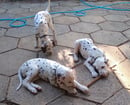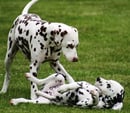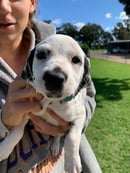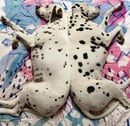Dalmatian Info & Dalmatian Breeders
Dalmatian Temperament
Dalmatians should be of good demeanor. Free of fear and aggression. They are social dogs, courteous to other animals and people alike but loyal and loving to their owner. They are playful and energetic. Enthusiastic companions for every activity.
Skip to Registered Dalmatian Breeder list >
The ideal owner for a Dalmatian
Athletic people, Adult singles or couples, Families with older children. They are easily compatible with other pets.
Training and socialisation
Dalmatians require consistent and clearly defined boundaries. Some may be sensitive to corrections and negative markers and may easily become bored by repetitive drill like training. They most work best with positive training methods. Dalmatians are fast learners when presented with dynamic and fun sessions and are very versatile, suitable to a wide range of dog sports and activities. Any Dalmatian should be enrolled in puppy classes and dog school and a wide range of stimuli and experiences offered.
How much space and exercise to Dalmatians need?
Average and large backyard sizes are suitable for Dalmatians. They prefer to be included in day to day life so access indoors is preferred vs an outside only dog. They are a breed of great athletic ability and physical endurance so regular walks or runs are suggested. It is also really important that they are mentally stimulated in addition to physical activity.
Dalmatians and grooming
Dalmatians have a short easily maintained coat. They are generally low odour and very clean - Most dirt and mud will easily brush off the coat when dry. They are surprisingly prolific shedders. Be prepared to live with Dalmatian glitter if you choose to own this breed. Keep ears clean and dry to prevent ear infections. And as with every dog breed regular nail trimming and maintenance is required if the dog does not naturally wear the nails down.
Dalmatian colour variations
Standard Dalmatians come in 2 colours. Liver spotted (a deep brown) or Black spotted. Other colours do exist. But Responsible breeders breed to standard. Breeding for fad colours or traits is destructive, negligent and greedy.
General facts about Dalmatians
Average life expectancy: 10-14 years
Average weight: Females: 18-25 kg, Males: 22-35 kg
Average height (at withers): Females: 54-59 cm, Males: 58-63 cm
Potential health Issues in Dalmatians
Hyperuricosuria/Uric acid stone formation
Dalmatian’s unique metabolism stops a step earlier than other dog breeds which unfortunately makes them prone to forming very acidic urine and uric acid stones.
This is managed in 4 ways:
- a low purine diet for life
- hydration
- free access to toiletting
- Desexing only once mature or using methods which allows the urinary tract to mature to full size.
***The only exception to this is Low uric acid (LUA) Dalmatians. These dogs are related to a single pointer outcross to reintroduce normal metabolism and remove the affinity for uric stone formation from the breed. These are accepted as purebred dalmatians but are not very common.***
Deafness
Dalmatians are affected by congenital deafness. US statistics suggest 8% of Dalmatians are bilaterally deaf (can not hear in either ear) and 22% are unilaterally deaf (can only hear in one ear). All responsible breeders should have BAER testing completed by a vet on ALL their breeding dogs and puppies produced.
Ear infections and skin allergies
May affect some dogs especially in dog teenage years.
Fun Facts about Dalmatians
1. Some Dalmatians smile. The curl of the lip and baring of teeth can be confused for a snarl, but it is just their way of smiling and is usually a sign of affection or submission if they happen to be in trouble.
2. Dalmatians are born almost entirely white. Their spots develop later.
3. The Dalmatian is the only breed with the job of ‘coaching’ - running alongside carriages or horseback riders.
4. President George Washington was a Dalmatian enthusiast and breeder.
5. 101 Dalmatians was a disaster for the breed. Increased demand led to a lot of amateur breeders and puppy farmers flooding the market with unhealthy and bad temperament dogs. Not screening or educating owners meant a lot were not exercised, trained or socialised appropriately.
Biggest thanks to Wonderdal Dalmatians for contributing to this information, and Deb Raeburn for main photo.
Dalmatian History
The roles of this ancient breed are as varied as their reputed ancestors. They were used as dogs of war, guarding the borders of Dalmatia. Their dramatic markings and intelligence have made them successful circus dogs throughout the years. Dalmatians are perhaps best known for their role as fire-fighting apparatus escorts and firehouse mascots. Since Dalmatians and horses are very compatible, the dogs were easily trained to run in front of the carriages to help clear a path and quickly guide the horses and firefighters to the fires. Fire engines used to be drawn by fast and powerful horses, a tempting target for thieves, so Dalmatians were kept in the firehouse as deterrence to theft. Source: Dalmatian Breed Information - History - Wikipedia
If you are a small scale ANKC registered breeder and would like to be listed here, just contact us or follow a few simple steps to add your details yourself.
We welcome helpful comments and contributions to information about this breed by email
Registered Dalmatian Breeders
We prefer our dogs to be part of our family ... read more
Friendly, trainable, versatile and much loved Dalmatians raised in the ... read more
Dalmations Might Be The Best Breed Ever!Dalmatians are a firefighter's best friend! Learn about these incredibly pups and show us a photo of your pet in the comments below!
Posted by Animalist on Tuesday, 13 October 2015















.jpg)
.jpg)
.jpg)